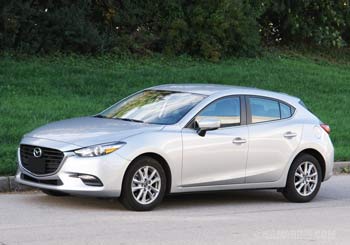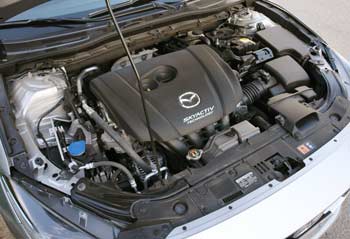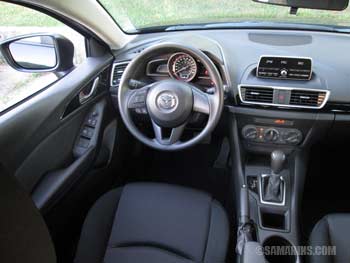Mazda 3 2014-2018 review: pros and cons, problems
By Vlad Samarin. Updated: March 01, 2023
The 2014-2018 Mazda 3 is a front-wheel drive compact car (sedan or hatchback). It offers top safety ratings, good fuel economy and sporty driving experience. 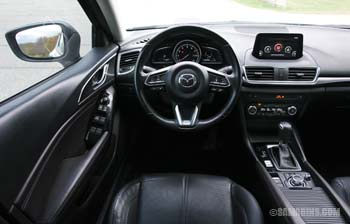
2018 Mazda 3 GT interior. #reviews
The interior is nicely finished. Except for the base model, the Mazda 3 comes with the 7-inch display.
If extra safety is a priority for you, advanced safety features such as lane departure warning, radar cruise control, rear cross traffic alert are available on top trim levels. The 2014-2018 Mazda3 scored a 5-star overall NHTSA safety rating.
Pros:
- Sporty looks, fun to drive.
- 5-star overall safety rating in NHTSA crash tests.
- Advanced safety features are available on top trims.
- Bulletproof engines, conventional 6-speed automatic transmission.
- Good on gas: the 2015-2016 2.0L auto Mazda 3 is rated at 33 mpg combined.
- The risk of expensive engine or transmission failures is low.
- For drivers who value high-end features, there is a well-equipped GT model with leather seats, a faster 2.5L engine and many high-end features.
- The ride is on the firm side and some road noise is noticeable.
- The quality of fabric seats and some interior plastic could be better.
- The interior space is limited and the trunk is fairly small.
- The infotainment system (Mazda Connect) can be slow and glitchy.
Overall it's a reliable car that can last for over 200,000 miles with good care. We would not hesitate to recommend it, provided it's in good mechanical condition. Read more about the problems:
Front wipers can stop working due to a problem with the front body control module (F-BCM). Mazda has issued Safety Recall 3219D to address this problem. The front BCM will need to be replaced.
Mazda issued the recall 1217F for the rear parking brake actuators (part of a rear brake caliper), as well as a few other service campaigns/recalls. Check for outstanding recalls at the NHTSA website using the VIN number or your car.
In models with manual HVAC controls, a small plastic arm that pops out of its place can cause the heater to blow cold air. You might notice that the temperature knob feels like it's no longer connected to the HVAC unit. The problem part is located behind the glove box. The fix is easy: the link set ($20 part) must be replaced. It's also possible that re-installing the arm properly can fix the problem; watch this video.
2019 Update: The warranty on the Mazda Connect screen has been extended for some models (Google "SSPB6"). The repair involves replacing the touch-screen only part, which is much cheaper than the display unit.
When checking a used Mazda 3 with the Mazda Connect infotainment system, test all areas of the touchscreen carefully, you may find that some areas are not responding to the touch. Base models come with a simple audio system without a touchscreen and don't have this problem.
A failed mass air flow sensor can cause the vehicle not to start. An OEM sensor costs $130-$180; an aftermarket part is cheaper. The sensor is located above the air filter box and is easy to replace.
A leaking serpentine belt hydraulic tensioner may need to be replaced together with the serpentine belt ($250-$380 repair), as it may rattle on acceleration.
Advertisement
The Check Engine light with codes P011A Engine Coolant Temperature Sensor 1/2 Correlation and P2183 - ECT Sensor #2 Circuit Range/Performance could be caused by a bad coolant temperature sensor installed at the lower portion of the radiator (ECT sensor #2). The sensor is not very expensive and is fairly easy to replace.
A failed rear-view camera might cause a blurred image on the screen. The rear-view camera is common to fail and is not very difficult to replace. Check the price with your dealer.
Noisy wheel bearings are not uncommon at higher mileage. A typical wheel bearing noise (humming) is more noticeable at highway speeds; the noise changes when the vehicle changes direction of travel. Replacing one wheel bearing (hub assembly) costs $290-$450.
Rear coil springs can break. It's usually recommended to replace both springs at the same time, but if you want to save money, replacing only the broken spring can be enough. The rear sway bar links might also need to be replaced if they cannot be removed without damaging them. Replacing one rear coil spring will cost $290-$450.
Rear shock absorbers might leak at a higher mileage ($180-$320 to replace one shock absorber). Failing shock absorbers and wheel bearings are common in many cars.
A bad ignition coil can cause the engine to misfire. Replacing one ignition coil ($45-120 part) is easy. If an updated part is available, your mechanic may recommend replacing all 4 ignition coils as a precaution. At higher mileage, it is also recommended to replace all four spark plugs if the engine misfires.
As in any vehicle with direct injection, carbon deposits on the intake valve can also cause misfiring at higher mileage. Cleaning intake valves manually will cost $350-$480.
A dead battery in the key fob can cause the car not to start. To start the car, hold the fob close to the start button. The fob battery is cheap and easy to replace.
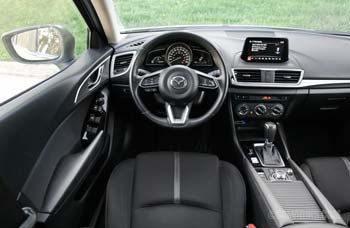
2018 Mazda 3 fabric interior. #How to inspect?
Many complaints are focused on the infotainment system (Mazda Connect). Some of the problems were fixed by the updates done at the dealer. A base model without Mazda Connect is a better choice if reliability is more important. For navigation map updates, visit Mazdahandsfree.com website.
Summary: Is the 2014-2018 Mazda 3 a good car to buy? Yes, provided that it's in top mechanical shape and not rusted. The Mazda 3 is fun to drive and offers a reliable powertrain, top crash-test scores and good fuel economy. It won't cost a lot to maintain and is easy to work on.
Tip from Mazda tech: Change your transmission fluid every 100K miles using original Mazda transmission fluid. Keep the coolant level topped up. Have your brakes serviced at least once a year. If you drive in the Salt Belt, consider rust-proofing.Engine choices: Mazda 3 comes with a 155-hp 2.0L or 184-hp 2.5L Skyactiv-G naturally-aspirated (non-turbo) inline-4 motors. The design of both engines is similar and even on the outside it's hard to tell them apart. Both are high-compression double overhead cam (DOHC) engines and both have Direct Fuel Injection.
In direct injection, fuel is injected under high pressure directly into the combustion chamber. Read also: Pros and cons of buying a car with Direct Injection. Both the Skyactiv 2.0L and 2.5L are excellent fuel-efficient motors and with proper maintenance can last for over 200K miles.
Mazda recommends using SAE 0W-20 oil for either of these engines. The oil capacity (with oil filter replacement) is specified at 4.4 US qt. or 4.2 liters for the Skyactiv-G 2.0L engine and 4.8 US qt. or 4.5 liters for the Skyactiv-G 2.5 motor. What is interesting, while many modern cars suffer from increased oil consumption, Skyactiv-G engines don't have this problem.
Timing belt or chain: Both the 2.0L and 2.5L Skyactiv gasoline engines have a timing chain. A chain doesn't need to be replaced unless it is stretched or worn out. There is no timing belt.
How to reset Maintenance Required light (wrench)? It should be reset after every oil change.
From the home screen on the Mazda Connect: Click Apps
Select and click Vehicle Status Monitor
Click on Maintenance
Click on the warning that has a wrench sign displayed in front of it.
Select and click Reset.
Fuel Economy: For a sporty car with a conventional automatic transmission, Mazda 3 is very good on gas. The 2015-2016 Mazda 3 sedan with a 2.0L engine gets 30 mpg city and 40 mpg highway (7.8/5.9 L/100 km) according to EPA estimates. This means that on a long trip you can drive for up to 487 miles or 785 km. The 2014-2016 5-door 2.0L auto is rated at 29/39 mpg (8.1/6.9 L/100km). Fuel consumption figures for the 2015-2017 4-door 2.5L automatic are estimated at 27/36 mpg (8.7/6.5 L/100 km).
Mechanical: Mazda 3 has MacPherson struts on the front and an independent multi-link layout in the rear suspension. Transmission choices include a 6-speed manual or a conventional 6-speed automatic. Rear brakes are discs. Late models offer an electronic parking brake.
Related Reviews:
Honda Civic 2012-2015
Toyota Corolla 2014-2018
Toyota Corolla 2009-2013
Honda Accord 2008-2012
Toyota Camry 2012-2017
Mazda 6 2014-2019
Mazda CX-5 2013-2016
Mazda 3 2010-2013
Dodge Dart 2013-2016
What to look for when buying a used Mazda 3? Watch out for signs of a lack of maintenance. Read more: How to inspect a used car - illustrated guide. When buying a used Mazda 3, check the Mazda Connect screen and features carefully, as well as test the commander switch buttons, as they are common to stick.
When opting for a GT model with Active Driving Display, Smart City Brake Support, Lane Departure Warning and other high-tech gadgets, consider a good extended warranty; problems with any of these features will be expensive to repair.
Test the heater and A/C. During the test drive, watch out for harsh shifting or slipping of the transmission. Read more: Signs of automatic transmission problems when test driving a used car.
In a GT trim, the alloy rims must be checked if they are not bent. If the car comes from the Salt Belt, the underneath components must be carefully examined for rust damage during the pre-purchase inspection. Avoid the car if rust damage looks excessive, as some of the problems caused by rust can be costly to repair. Also avoid the car if the engine sounds too noisy or if the transmission doesn't shift smoothly.

